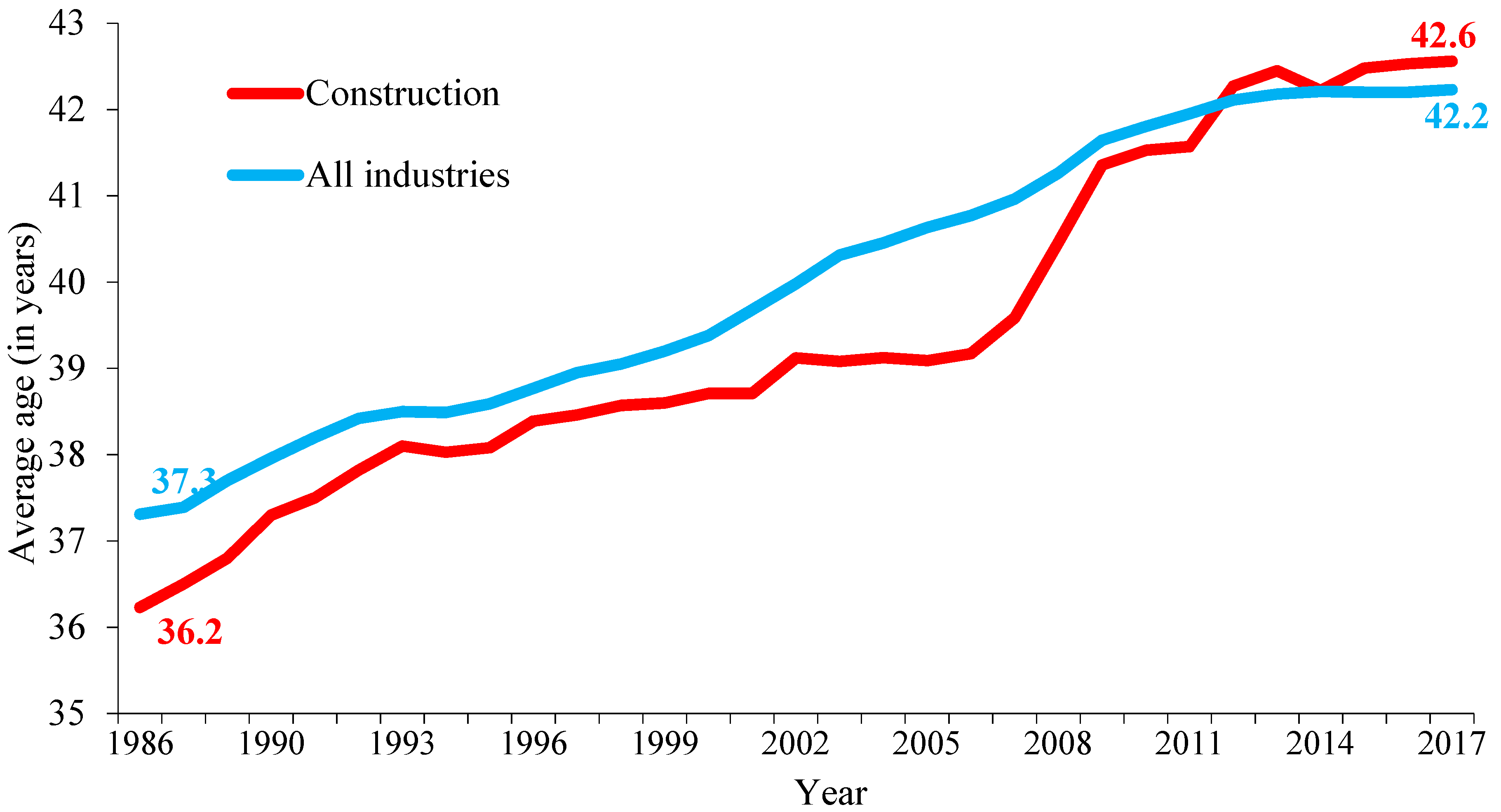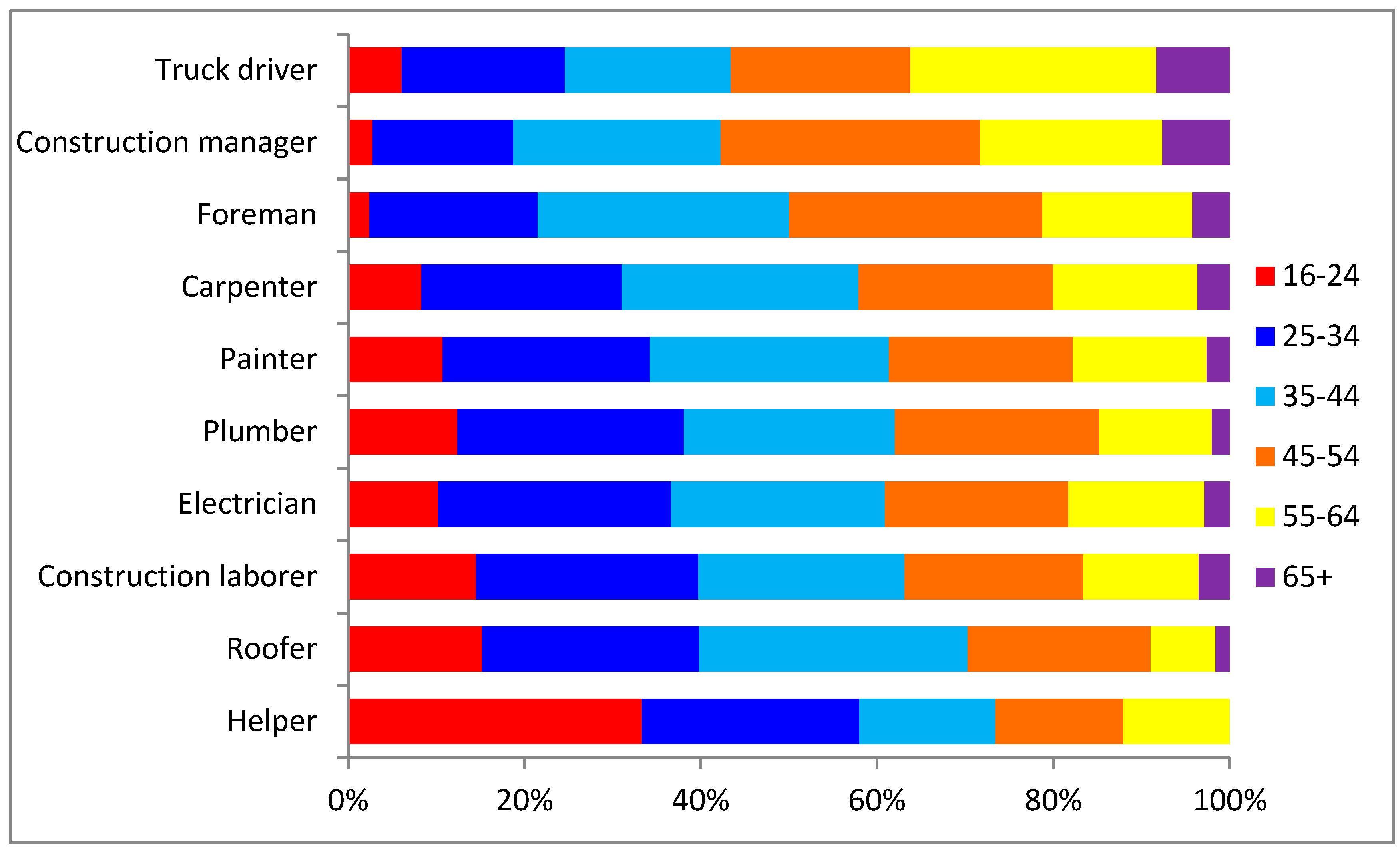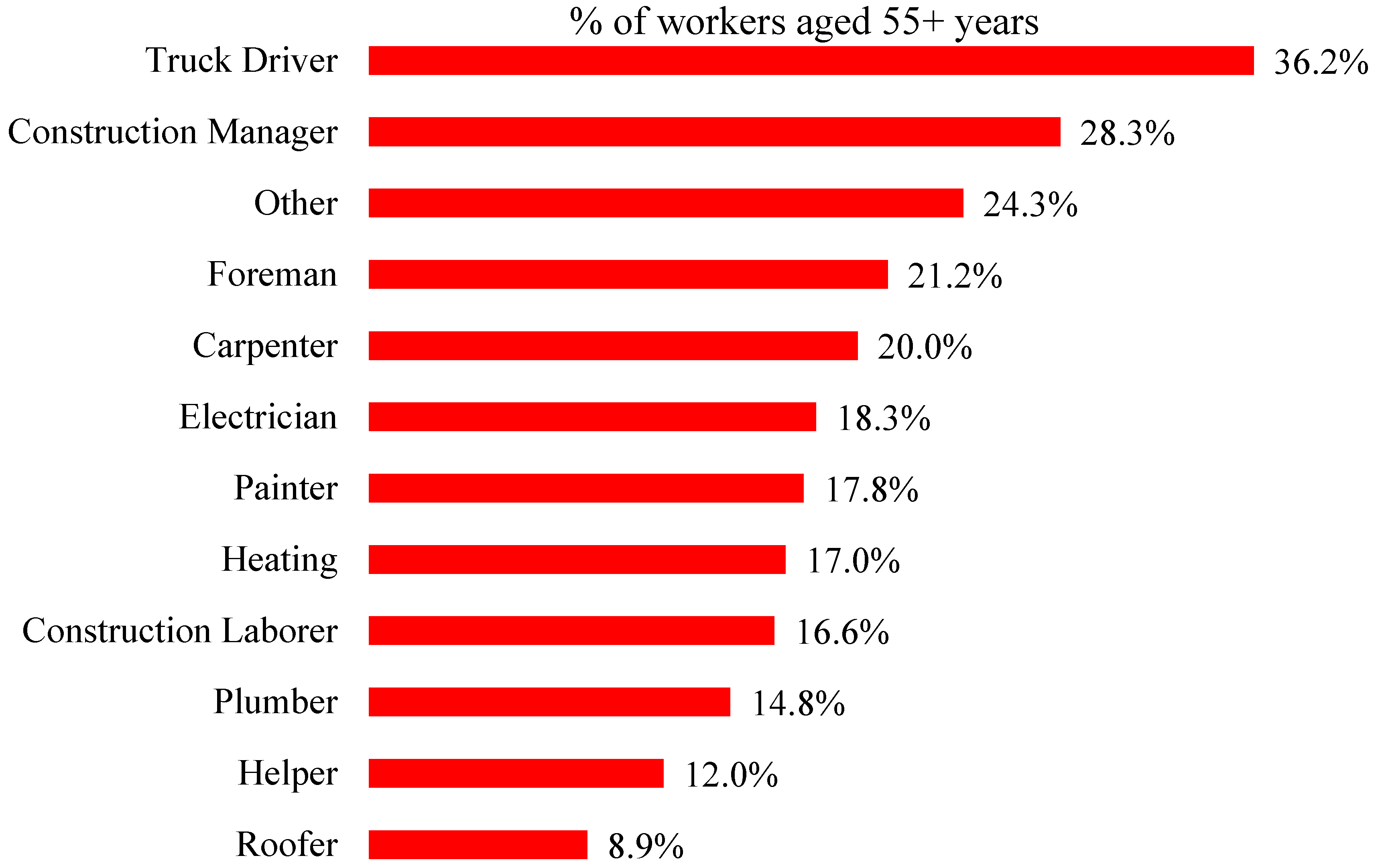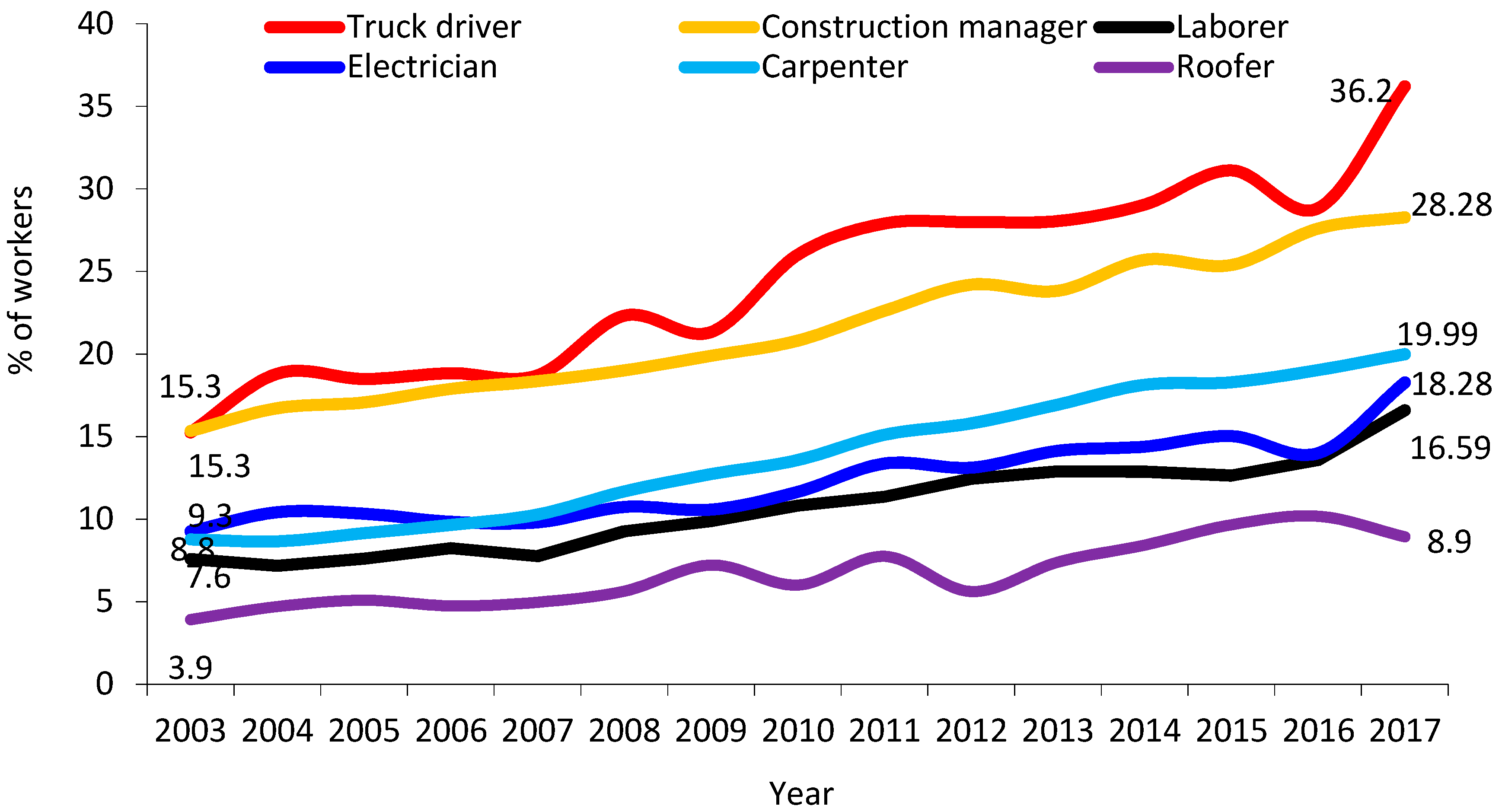Building a Sustainable Construction Workforce
Abstract
1. Introduction
2. Methods
2.1. Quantitative Methods
2.2. Qualitative Methods
3. Results
3.1. Quantitative Results
3.2. Qualitative Results
3.2.1. Aging Workers
3.2.2. Work Accommodations
3.2.3. How Unions Responded
Collective Bargaining Agreements (CBAs)
Mentoring/Pairing
Career Pathways
3.2.4. Other Needs Identified
3.2.5. Other Topics Raised
4. Discussion
5. Conclusions
Author Contributions
Acknowledgments
Conflicts of Interest
References
- Toosi, M. Labor Force Projections to 2024: The Labor Force is Growing, but Slowly. MLR 2015. [Google Scholar] [CrossRef]
- Lacey, T.A.; Toossi, M.; Dubina, K.S.; Gensler, A.B. Projections Overview and Highlights, 2016–2026. Mon. Labor Rev. 2017. [Google Scholar] [CrossRef]
- McFall, B.H. Crash and wait? The impact of the great recession on retirement planning of older Americans. Am. Econ. Rev. 2011, 101, 40–44. [Google Scholar] [CrossRef] [PubMed]
- Tang, F.; Choi, E.; Goode, R. Older Americans employment and retirement. Ageing Int. 2013, 38, 82–94. [Google Scholar] [CrossRef]
- Hurd, M.; Rohwedder, S. Trends in Labor Force Participation: How Much is due to Changes in Pensions? J. Popul. Ageing 2011, 4, 81–96. [Google Scholar] [CrossRef] [PubMed]
- Szinovacz, M.E.; Davey, A.; Martin, L. Did the Great Recession Influence Retirement Plans? Res. Aging 2015, 37, 275–305. [Google Scholar] [CrossRef] [PubMed]
- Ringen, K.; Dong, X.S.; Goldenhar, L.M.; Cain, C.T. Construction Safety and Health in the USA: Lessons from a Decade of Turmoil. Ann. Work Expo. Health 2018, 62, S25–S33. [Google Scholar] [CrossRef]
- Dong, X.S.; Wang, X.; Ringen, K.; Sokas, R. Baby Boomers in the United States: Factors Associated with Working Longer and Delaying Retirement. Am. J. Ind. Med. 2017, 60, 315–328. [Google Scholar] [CrossRef]
- CPWR. Worker Age in Construction and Other Industries. In Construction Chart Book: The U.S. Construction Industry and Its Workers; CPWR—The Center for Construction Research and Training: Silver Spring, MD, USA, 2018; p. 13. Available online: https://www.cpwr.com/chart-book-6th-edition-labor-force-characteristics-worker-age-construction-and-other-industries (accessed on 9 July 2019).
- Ervasti, J.; Pietilainen, O.; Rahkonen, O.; Lahelma, E.; Kouvonen, A.; Lallukka, T.; Manty, M. Long-Term Exposure to Heavy Physical Work, Disability Pension due to Musculoskeletal Disorders and all-Cause Mortality: 20-Year Follow-Up-Introducing Helsinki Health Study Job Exposure Matrix. Int. Arch. Occup. Environ. Health 2019, 92, 337–345. [Google Scholar] [CrossRef]
- CPWR. Demographic Trends of Fatal and Nonfatal Injuries in Construction. In The Construction Chart Book: The U.S. Construction Industry and Its Workers; CPWR—The Center for Construction Research and Training: Silver Spring, MD, USA, 2018; p. 41. Available online: https://www.cpwr.com/chart-book-6th-edition-fatal-and-nonfatal-injuries-demographic-trends-fatal-and-nonfatal-injuries (accessed on 9 July 2019).
- Dong, X.S.; Wang, X.; Largay, J.A.; Sokas, R. Long-Term Health Outcomes of Work-Related Injuries among Construction Workers—Findings from the National Longitudinal Survey of Youth. Am. J. Ind. Med. 2015, 58, 308–318. [Google Scholar] [CrossRef]
- Dong, X.S.; Wang, X.; Largay, J.A.; Sokas, R. Economic Consequences of Workplace Injuries in the United States: Findings from the National Longitudinal Survey of Youth (NLSY79). Am. J. Ind. Med. 2016, 59, 106–118. [Google Scholar] [CrossRef] [PubMed]
- Scott, K.A.; Liao, Q.; Fisher, G.G.; Stallones, L.; DiGuiseppi, C.; Tompa, E. Early Labor Force Exit Subsequent to Permanently Impairing Occupational Injury or Illness among Workers 50–64 Years of Age. Am. J. Ind. Med. 2018, 61, 317–325. [Google Scholar] [CrossRef] [PubMed]
- Jarvholm, B.; Stattin, M.; Robroek, S.J.; Janlert, U.; Karlsson, B.; Burdorf, A. Heavy Work and Disability Pension—A Long Term Follow-Up of Swedish Construction Workers. Scand. J. Work Environ. Health 2014, 40, 335–342. [Google Scholar] [CrossRef] [PubMed]
- Welch, L.S.; Haile, E.; Boden, L.I.; Hunting, K.L. Impact of Musculoskeletal and Medical Conditions on Disability Retirement-a Longitudinal Study among Construction Roofers. Am. J. Ind. Med. 2010, 53, 552–560. [Google Scholar] [CrossRef]
- West, G.H.; Dawson, J.; Teitelbaum, C.; Novello, R.; Hunting, K.; Welch, L.S. An Analysis of Permanent Work Disability among Construction Sheet Metal Workers. Am. J. Ind. Med. 2016, 59, 186–195. [Google Scholar] [CrossRef]
- Dement, J.; Welch, L.S.; Ringen, K.; Cranford, K.; Quinn, P. Hearing Loss among Older Construction Workers: Updated Analyses. Am. J. Ind. Med. 2018, 61, 326–335. [Google Scholar] [CrossRef]
- Ji, J.S.; Schwartz, J.; Sparrow, D.; Hu, H.; Weisskopf, M.G. Occupational Determinants of Cumulative Lead Exposure: Analysis of Bone Lead among Men in the VA Normative Aging Study. J. Occup. Environ. Med. 2014, 56, 435–440. [Google Scholar] [CrossRef]
- Jarvholm, B.; Burdorf, A. Effect of Reduced use of Organic Solvents on Disability Pension in Painters. Occup. Environ. Med. 2017, 74, 827–829. [Google Scholar] [CrossRef]
- Toren, K.; Jarvholm, B. Effect of Occupational Exposure to Vapors, Gases, Dusts, and Fumes on COPD Mortality Risk among Swedish Construction Workers: A Longitudinal Cohort Study. Chest 2014, 145, 992–997. [Google Scholar] [CrossRef]
- Borup, H.; Kirkeskov, L.; Hanskov, D.J.A.; Brauer, C. Systematic Review: Chronic Obstructive Pulmonary Disease and Construction Workers. Occup. Med. (Lond.) 2017, 67, 199–204. [Google Scholar] [CrossRef]
- Dement, J.M.; Welch, L.S.; Ringen, K.; Cranford, K.; Quinn, P. Longitudinal Decline in Lung Function among Older Construction Workers. Occup. Environ. Med. 2017, 74, 701–708. [Google Scholar] [CrossRef] [PubMed]
- Arndt, V.; Rothenbacher, D.; Daniel, U.; Zschenderlein, B.; Schuberth, S.; Brenner, H. Construction Work and Risk of Occupational Disability: A Ten Year Follow Up of 14,474 Male Workers. Occup. Environ. Med. 2005, 62, 559–566. [Google Scholar] [CrossRef] [PubMed]
- Yang, T.; Liu, T.; Lei, R.; Deng, J.; Xu, G. Effect of Stress on the Work Ability of Aging American Workers: Mediating Effects of Health. Int. J. Environ. Res. Public Health 2019, 16, 2273. [Google Scholar] [CrossRef] [PubMed]
- Dupre, M.E.; George, L.K.; Liu, G.; Peterson, E.D. The Cumulative Effect of Unemployment on Risks for Acute Myocardial Infarction. Arch. Intern. Med. 2012, 172, 1731–1737. [Google Scholar] [CrossRef]
- CPWR. Quarterly Data Report. First Quarter—Fall Injuries and Prevention in the Construction Industry. Available online: https://www.cpwr.com/publications/first-quarter-fall-injuries-and-prevention-construction-industry (accessed on 10 July 2019).
- CPWR. Quarterly Data Report. Second Quarter—Struck-by Injuries and Prevention in the Construction Industry. Available online: https://www.cpwr.com/publications/second-quarter-struck-injuries-and-prevention-construction-industry (accessed on 10 July 2019).
- CPWR. Quarterly Data Report. Fourth Quarter—Struck-by Injuries and Prevention in the Construction Industry. 2017. Available online: https://www.cpwr.com/publications/fourth-quarter-caught-inbetween-injuries-and-prevention-construction-industry (accessed on 10 July 2019).
- Merkus, S.L.; Lunde, L.K.; Koch, M.; Waersted, M.; Knardahl, S.; Veiersted, K.B. Physical Capacity, Occupational Physical Demands, and Relative Physical Strain of Older Employees in Construction and Healthcare. Int. Arch. Occup. Environ. Health 2019, 92, 295–307. [Google Scholar] [CrossRef] [PubMed]
- Wegman, D.H.; McGee, J.P. Health and Safety Needs of Older Workers; National Academies Press: Washington, DC, USA, 2004. [Google Scholar] [CrossRef]
- CPWR. The Center for Construction Research and Training. Healthy Aging for a Sustainable Workforce. Available online: https://www.cpwr.com/sites/default/files/publications/Aging%20Workers%20Workshop%20Report_11%2009_Final.pdf (accessed on 18 April 2019).
- Tonnon, S.C.; Van der Veen, R.; Westerman, M.J.; Robroek, S.J.; Van der Ploeg, H.P.; Van der Beek, A.J.; Proper, K.I. The Employer Perspective on Sustainable Employability in the Construction Industry. J. Occup. Environ. Med. 2017, 59, 85–91. [Google Scholar] [CrossRef] [PubMed]
- Tonnon, S.C.; Van der Veen, R.; De Kruif, A.T.C.M.; Robroek, S.J.W.; Van der Ploeg, H.P.; Proper, K.I.; Van der Beek, A.J. Strategies of Employees in the Construction Industry to Increase their Sustainable Employability. Work 2018, 59, 249–258. [Google Scholar] [CrossRef]
- Amick, B.C.; Hogg-Johnson, S.; Latour-Villamil, D.; Saunders, R. Protecting Construction Worker Health and Safety in Ontario, Canada: Identifying a Union Safety Effect. J. Occup. Environ. Med. 2015, 57, 1337–1342. [Google Scholar] [CrossRef]
- CPWR. Wages in Construction, by Demographic Characteristics, Unionization, and Region. In The Construction Chart Book: The U.S. Construction Industry and Its Workers, 6th ed.; CPWR—The Center for Construction Research and Training: Silver Spring, MD, USA, 2018; p. 24. Available online: https://www.cpwr.com/chart-book-6th-edition-employment-and-income-wages-construction-demographic-characteristics (accessed on 18 April 2019).
- SAS Institute Inc. SAS/STATR 9.4. 2014. Available online: https://www.sas.com/en_us/software/sas9.html (accessed on 8 July 2019).
- NABTU. North America’s Building Trades Union. 2019. Available online: https://nabtu.org/ (accessed on 8 July 2019).
- Dicicco-Bloom, B.; Crabtree, B.F. The Qualitative Research Interview. Med. Educ. 2006, 40, 314–321. [Google Scholar] [CrossRef]
- Karimi, H.; Taylor, T.R.B.; Goodrum, P.M. Analysis of the Impact of Craft Labour Availability on North American Construction Project Productivity and Schedule Performance. Constr. Manag. Econ. 2017, 35, 368–380. [Google Scholar] [CrossRef]
- Bigelow, B.F.; Zarate, V.; Soto, J.; Arenas, J.; Perrenoud, A. Attracting and Retaining Tradespeople, an Evaluation of Influencers on Construction Workers in Two Different Trades in Texas. Int. J. Constr. Educ. 2019, 15, 163–178. [Google Scholar] [CrossRef]
- Truxillo, D.M.; Cadiz, D.M.; Hammer, L.B. Supporting the Aging Workforce: A Review and Recommendations for Workplace Intervention Research. Annu. Rev. Organ. Psychol. Organ. Behav. 2015, 2, 351–381. [Google Scholar] [CrossRef]
- Manty, M.; Kouvonen, A.; Lallukka, T.; Lahti, J.; Lahelma, E.; Rahkonen, O. Changes in Physical and Mental Health Functioning during Retirement Transition: A Register-Linkage Follow-Up Study. Eur. J. Public Health 2018, 28, 805–809. [Google Scholar] [CrossRef] [PubMed]
- Burdorf, A.; Winchorst, J.; Van der Beck, A.J.; Van der Molen, H.; Swuste, P.H.J.J. The Effects of Mechanised Equipment on Physical Load among Road Workers and Floor Layers in the Construction Industry. Int. J. Ind. Ergon. 2007, 37, 133–143. [Google Scholar] [CrossRef]
- Rempel, D.; Barr, A. A Universal Rig for Supporting Large Hammer Drills: Reduced Injury Risk and Improved Productivity. Saf. Sci. 2015, 78, 20–24. [Google Scholar] [CrossRef] [PubMed][Green Version]
- Jensen, L.K.; Friche, C. Implementation of New Working Methods in the Floor-Laying Trade: Long-Term Effects on Knee Load and Knee Complaints. Am. J. Ind. Med. 2010, 53, 615–627. [Google Scholar] [CrossRef]
- Eaves, S.; Gyi, D.E.; Gibb, A.G. Building Healthy Construction Workers: Their Views on Health, Wellbeing and Better Workplace Design. Appl. Ergon. 2016, 54, 10–18. [Google Scholar] [CrossRef]
- Marchiondo, L.A.; Gonzales, E.; Williams, L.J. Trajectories of Perceived Workplace Age Discrimination and Long-Term Associations with Mental, Self-Rated, and Occupational Health. J. Gerontol. B Psychol. Sci. Soc. Sci. 2019, 74, 655–663. [Google Scholar] [CrossRef]




| U.S. Born | Immigrants | p-Value * | |||||
|---|---|---|---|---|---|---|---|
| Occupation | Mean | 95% CI | Mean | 95% CI | |||
| Construction Manager | 46.8 | 46.2 | 47.3 | 44.6 | 43.3 | 46.0 | <0.0001 |
| Foreman | 45.4 | 44.8 | 46.0 | 44.2 | 42.8 | 45.6 | <0.05 |
| Carpenter | 42.0 | 42.5 | 43.5 | 40.9 | 40.2 | 41.6 | <0.0001 |
| Construction Laborer | 38.6 | 38.1 | 39.2 | 40.1 | 39.6 | 40.6 | <0.01 |
| Electrician | 40.2 | 39.5 | 41.0 | 42.1 | 40.6 | 43.7 | <0.05 |
| Painter | 43.5 | 42.5 | 44.5 | 39.2 | 38.4 | 40.1 | <0.0001 |
| Plumber | 41.4 | 40.6 | 42.2 | 41.4 | 39.8 | 42.9 | >0.05 |
| Roofer | 37.2 | 35.8 | 38.6 | 37.7 | 36.6 | 38.9 | >0.05 |
| Helper | 30.4 | 27.9 | 32.9 | 36.3 | 32.8 | 39.9 | >0.05 |
| Heating | 40.0 | 39.1 | 40.9 | 40.8 | 38.5 | 43.0 | >0.05 |
| Truck Driver | 46.2 | 44.9 | 47.6 | 45.2 | 42.7 | 47.7 | >0.05 |
| Other | 44.2 | 43.9 | 44.48 | 42.5 | 42.0 | 43.1 | <0.0001 |
| Total | 43.0 | 42.8 | 43.2 | 41.1 | 40.9 | 41.4 | <0.0001 |
| Key Informant Interview Participants | Informal E-Mail Information from Additional Sources | Safety and Health Committee Input |
|---|---|---|
| 17 union representatives from 13 individual craft trades | E-mail responses from two union representatives declining full interviews | Preliminary presentation of issue and requires for information |
| One representative from NABTU as an organization | One email response from a NABTU representative | Review of and input into script/question development. |
| One university program director (online program) | E-mail and telephone follow up from participant in second Committee discussion | Presentation of preliminary findings—“Did we get it right? Did we get it all?” |
| Union | Non-Union | p-Value * | |||||
|---|---|---|---|---|---|---|---|
| Occupation | Mean | 95% CI | Mean | 95% CI | |||
| Foreman | 46.5 | 45.2 | 47.8 | 43.9 | 43.2 | 44.6 | <0.0001 |
| Construction Manager | 45.1 | 42.9 | 47.3 | 44.7 | 44.0 | 45.4 | <0.0001 |
| Truck Driver | 45.1 | 42.0 | 48.1 | 45.7 | 44.4 | 47.0 | 0.01 |
| Construction Laborer | 41.7 | 40.4 | 42.9 | 37.4 | 37.0 | 37.8 | <0.0001 |
| Plumber | 41.1 | 39.7 | 42.6 | 39.3 | 38.4 | 40.2 | <0.0001 |
| Carpenter | 41.0 | 39.8 | 42.2 | 39.0 | 38.4 | 39.5 | <0.0001 |
| Painter | 41.0 | 37.9 | 44.0 | 38.7 | 37.9 | 39.5 | <0.0001 |
| Roofer | 40.6 | 37.4 | 43.9 | 36.1 | 35.1 | 37.1 | <0.0001 |
| Electrician | 40.1 | 38.9 | 41.3 | 38.7 | 37.8 | 39.5 | <0.0001 |
| Heating | 37.5 | 35.4 | 39.6 | 38.4 | 37.5 | 39.4 | <0.0001 |
| Helper | 34.9 | 27.5 | 42.3 | 32.2 | 30.0 | 34.4 | >0.05 |
| Other | 44.0 | 43.3 | 44.7 | 42.2 | 41.9 | 42.5 | <0.0001 |
| Total | 42.5 | 42.0 | 42.9 | 40.5 | 40.3 | 40.7 | <0.0001 |
© 2019 by the authors. Licensee MDPI, Basel, Switzerland. This article is an open access article distributed under the terms and conditions of the Creative Commons Attribution (CC BY) license (http://creativecommons.org/licenses/by/4.0/).
Share and Cite
Sokas, R.K.; Dong, X.S.; Cain, C.T. Building a Sustainable Construction Workforce. Int. J. Environ. Res. Public Health 2019, 16, 4202. https://doi.org/10.3390/ijerph16214202
Sokas RK, Dong XS, Cain CT. Building a Sustainable Construction Workforce. International Journal of Environmental Research and Public Health. 2019; 16(21):4202. https://doi.org/10.3390/ijerph16214202
Chicago/Turabian StyleSokas, Rosemary K., Xiuwen Sue Dong, and Chris Trahan Cain. 2019. "Building a Sustainable Construction Workforce" International Journal of Environmental Research and Public Health 16, no. 21: 4202. https://doi.org/10.3390/ijerph16214202
APA StyleSokas, R. K., Dong, X. S., & Cain, C. T. (2019). Building a Sustainable Construction Workforce. International Journal of Environmental Research and Public Health, 16(21), 4202. https://doi.org/10.3390/ijerph16214202





